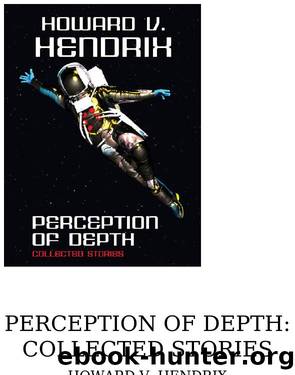Perception of Death: Collected Stories by Howard V. Hendrix

Author:Howard V. Hendrix
Language: eng
Format: epub
Publisher: Wildside Press
Published: 2011-06-14T16:00:00+00:00
STAGES OF NIGHT AND TWILIGHT
Momentarily disoriented, Martin stared at the holes in the metal plate for Lalande 21185, tonightâs target star. Had he come back too soon? Believing that work would take his mind off what had happened, Martin Merrill had eagerly returned to his research at the Allegheny Observatory. Now, however, he wondered if he hadnât been too eager.
All day long he had felt out of phase and out of focus. From the moment his alarm clock went off that morning, the world had played on him like two radio stations of widely different formats interfering with each other on the same broadcasting frequency and switching unpredictably back and forth between them.
Shaking his head and smiling crookedly, Martin tried to think only of well-behaved quanta as he plugged the last of the fiber-optic leads into the pre-drilled holes of the Lalande plate. Finished, he let his gaze drift upward, along the barrel of the Thaw Memorial Telescope. The Thawâs thirty-inch lens and its focal length of 561 inches gave it an overall f-number of about nineteenâample enough for gathering the photons which the fiber-optic leads piped to MAPS, the Multichannel Astrometric Photometer and Spectrometer.
As his gaze continued upward, Martinâs crooked smile broadened. An awful lot of equipment, just to discern a tiny wobble in one of innumerable stars. Wobbles, phases, and shiftsâproofs of the invisible tugging at the visibleâwere what it was all about in the search for extra-solar planets, or ESPs, as some of his less sympathetic colleagues called them. Lalande 21185 apparently wobbled in tune to not one but two invisible objects of near-Jovian mass. At only eight light years out, tonightâs target was right in the neighborhood, too.
Above him, beyond the end of the telescope, the bent blue monolith of twilight sky shone down through the open-shuttered observatory dome. Soon, the Earth would spin the observatory down the stages of twilight and that bright-dark rectangle above him would fill with stars. Tonight, however, the tall rectangular slit seemed at once two, three, and n-dimensionalâas if, in the bend of that plank of twilight, he saw the curvature of spacetime itself. Rationally he knew that bend to be merely the product of the observatory domeâs own curvature, but twilight was always a good time for illusions.
Another of his favorite romanticisms (as he preferred to call such twilight illusions) was that the Thaw telescope, which had gathered first light in August of 1914, partook somehow of the character of those other guns of that August, those whose voices had signalled the start of the First World War. The Thaw resembled, for him, a cannon of particularly large bore and lengthâa howitzer pointed at the heavens, trained upon its celestial target. Sometimes he mused that, just as the sound of the cannonball or shell, moving as a coherent wave, always paradoxically arrives at the target zone in reverse order, before the order to âFire!â, so too at twilight it seemed to him that the role of the big telescope
Download
This site does not store any files on its server. We only index and link to content provided by other sites. Please contact the content providers to delete copyright contents if any and email us, we'll remove relevant links or contents immediately.
What's Done in Darkness by Kayla Perrin(25490)
Shot Through the Heart: DI Grace Fisher 2 by Isabelle Grey(18208)
Shot Through the Heart by Mercy Celeste(18151)
The Fifty Shades Trilogy & Grey by E L James(17767)
The 3rd Cycle of the Betrayed Series Collection: Extremely Controversial Historical Thrillers (Betrayed Series Boxed set) by McCray Carolyn(13180)
The Subtle Art of Not Giving a F*ck by Mark Manson(12896)
Scorched Earth by Nick Kyme(11821)
Stepbrother Stories 2 - 21 Taboo Story Collection (Brother Sister Stepbrother Stepsister Taboo Pseudo Incest Family Virgin Creampie Pregnant Forced Pregnancy Breeding) by Roxi Harding(11014)
Drei Generationen auf dem Jakobsweg by Stein Pia(10208)
Suna by Ziefle Pia(10178)
Scythe by Neal Shusterman(9249)
International Relations from the Global South; Worlds of Difference; First Edition by Arlene B. Tickner & Karen Smith(8599)
Successful Proposal Strategies for Small Businesses: Using Knowledge Management ot Win Govenment, Private Sector, and International Contracts 3rd Edition by Robert Frey(8404)
This is Going to Hurt by Adam Kay(7680)
Dirty Filthy Fix: A Fixed Trilogy Novella by Laurelin Paige(6444)
He Loves Me...KNOT by RC Boldt(5795)
How to Make Love to a Negro Without Getting Tired by Dany LaFerrière(5366)
Interdimensional Brothel by F4U(5298)
Thankful For Her by Alexa Riley(5148)
